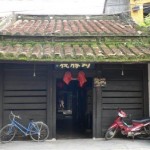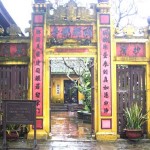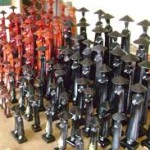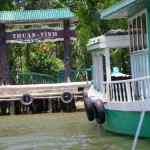The Quan Cong Temple, also called Ong Pagoda, is a very famous temple in Hoi An and it stands at on Nguyen Hue Streets (No 24, Nguyen Hue Str), near the central market. This temple, typical of ancient architectural constructions, was built by the Minh Huong people (Chinese immigrants) together with Viet people. It was recognized as a “National Historic and Cultural Site” on 29 November 1991
Originally, the Quan Kong Temple was made especially for merchants from various places, who used to come here and pay respect their ancestors. The temple is a symbol of their bravery, loyalty, and virtue. Besides two wooden statues, inside the temple there is also a small pond. When arriving or before leaving the port, ships and boats used to come to Quan Cong Temple to make votive offerings to thank the genie or to pray for luck in their trips.
There are many exciting things inside the Quan Cong Temple, among which two huge statues, almost 10 feet high, made of wood and kept in the altar. One of these statues is the idol of the protector of Quan Cong, while the other one features the adopted son of the protector. Both these attractive specimens of architecture deserve the appreciation of the visitors.
The Quan Cong temple festival is held twice a year according to the lunar calendar: the birthday of the genie (on 13 of the first lunar month) and the death anniversary of the genie (on 24 of the sixth lunar month). These festivals attract a lot of believers and pilgrims from all over the country.
The temple was built in 1653 and dedicated to Quan Cong, a prominent mandarin of the Han Dynasty, who lived in the time of “Three Warring Kingdoms” (3rd century AD). He was a talented and virtuous general, a symbol of courage, loyalty, piety moderation and righteousness in the feudal time of China. Though restored many times in (1753, 1783, 1827,1864, 1904 and 1966), the temple’s original structure has been kept almost the same.
Quan Cong Temple’s structure resembles the Chinese character “Quoc” (meaning country) and is divided into many rows of houses. The roofs are covered with green-glazed tube-tiles. The top-edges are heaped up and decorated with patterns of dragons and unicorns, and paved with colorful ceramic nieces. The structure is composed of three parts : front hall, open yard and back hall (sanctuary).
In the front hall, at the ends of the beams under the roofs are attached four blocks of wood carved with overlapping lotus petals, which are painted pink and called lanterns” (these “beams” architectural feature can be seen in most of the pagodas and temples in Hoi An). On the entrance door to the temple are carved in relief a couple of blue dragons winding their bodies amid white clouds legend has it that Quan Cong is the embodiment of Thanh Long (Blue Dragon) and Bach Ho (White Tiger). Above them is pair of “mat cua” (Eyes of door).
The front hall is smaller than the back one. It has three compartments and two lean-tos. The rafter that supports the roof has an overlapping structure with a hand-like part. Right in the middle of the front hall is the altar dedicated to Quan Cong’s guards. On both sides are hung banners, which are written with four Chinese characters “Hiep Thien Dai De” (The King who acts in accordance with Heaven’s rule). On both sides of the altar are a set of ritual weapons and objects used for processions. On the wall opposite to the altar, just beneath the lower edge of the roof, is hung a hoanh phi (rectangular wooden plank) inscribed with two Chinese characters ‘Nghia khi” (Righteousness and Will). Above the altar is a red baldachin bearing four yellow Chinese characters “Quan Thanh De Quan”. Below the baldachin is a hoanh phi with a red background and four black Chinese characters “Hao Khi Lang Tieu” (the mettle soars into the sky).
On the two sides of the tone bronze altar are a half-a-bell and a huge drum supported by a wooden stand, which was granted by King Bao Dai. Besides, there are many parallel sentences hung on the post rows at the back on the front hall. They were offered to the temple by kings, lords, famed intellectuals tradesmen to praise the talent influential of Quan Cong.
The statue of Quan Cong is nearly 3m high. The face is red with phoenix-like eyes and a long beard. The two hands are clasped together. He is dressed green royal robe and majestically rides in a kneeling white horse. He is looking down at his two fostered children in an imposing manner.
On the right, stands the statue of Quan Binh and on the left side, the statue of Chau Thuong, a civilian mandarin and a military mandarin, as well as Quan Cong’s fostered children. They stand in a posture that shows that they are ready to die for their master. In the main sanctuary, there is a large wooden board engraved with a long poem of Duke Nguyen Nghiem (the father of great poet Nguyen Du), which praises of merit and virtue of Quan Cong. Both these attractive specimens of architecture deserve the appreciation of the visitors
On both sides of the sanctuary are two life-size wooden coursers of Quan Cong, the White Horse, on the left and the Sorrel, on the right. On the wall behind the altar is hung a valuable brown-stripped the grey brocade royal robe, which the Minh Huong people offered to the temple in the 18th century.
The temple contains about 30 horizontal lacquered boards (Hoanh phi), over ten pairs of parallel sentences, many and Tang poems written by famed intellectuals, which teach patriotism, loyalty, piety, moderation and righteousness. These relics are the symbol of a noble philosophy of life, which esteems the “heart” of the Vietnamese, Chinese and Japanese people of Hoi An. Quan Cong temple is a shrine where numerous adepts come to conduct religious services.
Soure: hoiantourism.com
Post Views:
2,100







